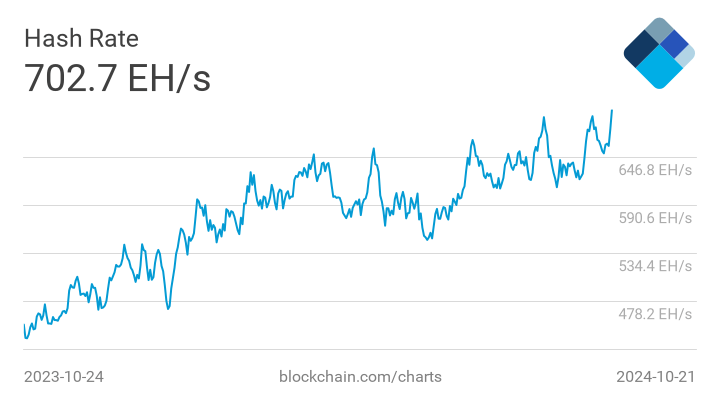Bitcoin Mining Difficulty Hits All-Time High
The mining difficulty of Bitcoin has achieved a historic peak, catalyzed by an exceptional increase in the network’s seven-day moving average hash rate.
Record Hash Rate Achieved
On October 21, Blockchain.com reported that Bitcoin’s seven-day hash rate soared to an unprecedented 703 exahashes per second (EH/s). This milestone marks the first time the network has surpassed the 700 EH/s threshold.

Importance of Hash Rate
The hash rate is a crucial metric as it represents the computational power being employed to solve intricate mathematical problems essential for transaction verification and adding new blocks to the blockchain.
Stable Growth Despite Halving
Over the past year, the hash rate has demonstrated steady growth even in the aftermath of Bitcoin’s halving event, which reduced miners’ rewards from 6.25 BTC to 3.125 BTC. Consequently, daily Bitcoin production was cut from 900 BTC to 450 BTC.
Recent Increases in Difficulty
Just a day after the hash rate spike, on October 22, Bitcoin’s mining difficulty rose by approximately 4% to reach 95.67 trillion. This adjustment reflects a response to the increasing computational power dedicated to mining.

How Difficulty Adjustments Work
Bitcoin adjusts its mining difficulty every 2,016 blocks, approximately every two weeks. This mechanism ensures consistent block discovery times. As difficulty increases, miners must deploy more computational resources to successfully mine each block.
The Impact of Increased Difficulty
An uptick in mining difficulty typically signals greater participation from miners, resulting in heightened overall computational demands. This increased difficulty not only bolsters the security of the blockchain but also makes it more challenging for malicious entities to execute attacks on the network.
Future Projections
According to Hashrate Index, the mining difficulty of Bitcoin is anticipated to reach 100 trillion by the year’s end, correlating with a sustained seven-day hash rate exceeding 700 EH/s.







